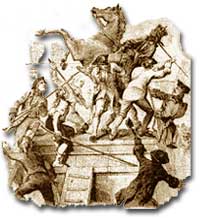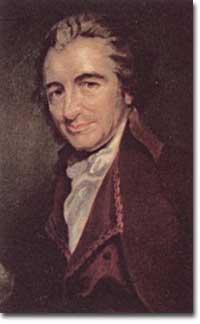11b. Loyalists, Fence-sitters, and Patriots

After patriots tore down the statue of King George III in New York City on July 9, 1776, they melted parts of it down and made bullets to use against the British.
It is impossible to know the exact number of American colonists who favored or opposed independence.
For years it was widely believed that one third favored the Revolution, one third opposed it, and one third were undecided. This stems from an estimate made by John Adams in his personal writings in 1815.
Historians have since concluded that Adams was referring to American attitudes toward the French Revolution, not ours. The current thought is that about 20 percent of the colonists were Loyalists — those whose remained loyal to England and King George. Another small group in terms of percentage were the dedicated patriots, for whom there was no alternative but independence.
On the Fence
Often overlooked are the fence-sitters who made up the largest group.
With so many Americans undecided, the war became in great measure a battle to win popular support. If the patriots could succeed in selling their ideas of revolution to the public, then popular support might follow and the British would be doomed.

In "Common Sense," Thomas Paine argued for independence from Britain and the creation of a democratic republic. Its publication in January 1776 immediately added fuel to the patriots' cause.
Even with military victory, it would have been impossible for the Crown to regain the allegiance of the people. Revolution would merely flare up at a later date.
The British understood the need to attract American popular support for the parent country, as well. Some colonists who were not persuaded by the political struggle joined the British for personal gain or military glory. Some joined out of sheer loyalty to the Crown — they still believed themselves loyal British citizens. There were also many American farmers willing to sell their goods to the British for profit.
In the long run, however, the patriots were much more successful attracting support. American patriots won the war of propaganda. Committees of Correspondence persuaded many fence-sitters to join the patriot cause. Writings such as Thomas Paine's "Common Sense" stirred newfound American nationalism.
|
Excerpt of "Common Sense" IN the following pages I offer nothing more than simple facts, plain arguments, and common sense: and have no other preliminaries to settle with the reader, than that he will divest himself of prejudice and prepossession, and suffer his reason and his feelings to determine for themselves that he will put on, or rather that he will not put off, the true character of a man, and generously enlarge his views beyond the present day ... The Sun never shined on a cause of greater worth. 'Tis not the affair of a City, a County, a Province, or a Kingdom; but of a Continent — of at least one-eighth part of the habitable Globe. 'Tis not the concern of a day, a year, or an age; posterity are virtually involved in the contest, and will be more or less affected even to the end of time, by the proceedings now. Now is the seed-time of Continental union, faith and honour. The least fracture now will be like a name engraved with the point of a pin on the tender rind of a young oak; the wound would enlarge with the tree, and posterity read in it full grown characters. – Thomas Paine, "Common Sense" (1776) | ||

The American Revolution not only separated neighbors and friends, it devastated many families, including the Franklins. William Franklin, pictured here, a Loyalist, rarely, if ever, spoke to his Patriot father Ben after the war.
Patriots subjected Loyalists to public humiliation and violence. Many Loyalists found their property vandalized, looted, and burned. The patriots controlled public discourse. Woe to the citizen who publicly proclaimed sympathy to Britain.
Families were sometimes divided over the revolution. Benjamin Franklin's son, William, a Loyalist governor of New Jersey, supported the British effort during the war.
What Happened to the Loyalists?
In the end, many Loyalists simply left America. About 80,000 of them fled to Canada or Britain during or just after the war. Because Loyalists were often wealthy, educated, older, and Anglican, the American social fabric was altered by their departure. American history brands them as traitors. But most were just trying to maintain the lifestyles to which they had become accustomed. After all, history is always written by the winners.






